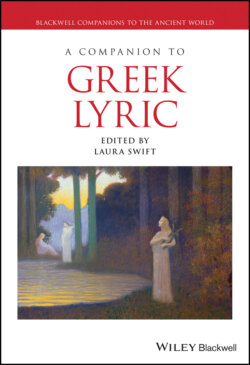Читать книгу A Companion to Greek Lyric - Группа авторов - Страница 24
The Lille Stesichorus
ОглавлениеThe religion of heroic epic emerges in another relatively recent find. Stesichorus had been hardly more than a name known for composing lyric narratives65 when, in Lille in the seventies of last century, Egyptian mummy cartonnage was unwrapped to reveal nearly a hundred lines of continuous verse in dactylo-epitrite meter on the subject of Theban myth (fr. 97 F).66 Scholars are nearly agreed, by now, that the author must be Stesichorus. The poem is hundreds of lines long, and written in lyric triads in marked Doric dialect. Of interest to us here is the interplay of religion and cult with the narrative. This concerns the Labdacid family, and in the recovered section, the strife prophesied for Oedipus’ children, Eteokles and Polyneikes. The intact section contains a dramatic dialogue between Jocasta (probably) and Teiresias, the famous Theban seer.67 First Jocasta speaks, mulling over the prospect of strife between her children: gods do not always give continuous strife to mortals on the “holy earth,” she says, but they alternate this daily with friendship (204–208 paraphrases). “Let us hope Lord Apollo the far-shooter does not bring all your prophesies to fulfillment” (209–210). She continues with another Homeric concept: the fate which men cannot escape. If, she says, it is my fate to witness my children killing each other68 let the end of death take me immediately before I see such misery in the home, or the city sacked (210–217 paraphrases). She concludes with a prayer that Zeus (228) may protect Thebes and put off the evil day predicted by Teiresias’ prophecy for as long as possible (230). All the Homeric concepts are there: Zeus himself, chief among many; fate in her various guises; Teiresias uttering prophecies as Chalkas did about Troy; Apollo as the mantic god deciding issues on earth by his arrows. In this poem the human level is represented by the heroic age; Iokaste’s fate is not paradigmatic of a contemporary situation, as it is in Archilochus’ Telephos poem, or Simonides’ ode on Plataia. In this sense, Stesichorus is “pure” Homer in a different metrical garb.69 Such heroic lyric narratives were, we are told, sung by choruses. We should imagine them performed, like Pindar’s choral lyric, at great occasions such as religious festivals, the marriage, or funeral, perhaps, of a Syracusan grandee. Culturally, they convey and propagate Homeric ideology, showing an heroic age in close contact with gods and goddesses, among other things through their prophets. Even Iokaste’s opinion that gods send mixed blessings and troubles to men has an Homeric model in Zeus’ jars of good and evil, which he variously doles out to mankind.
